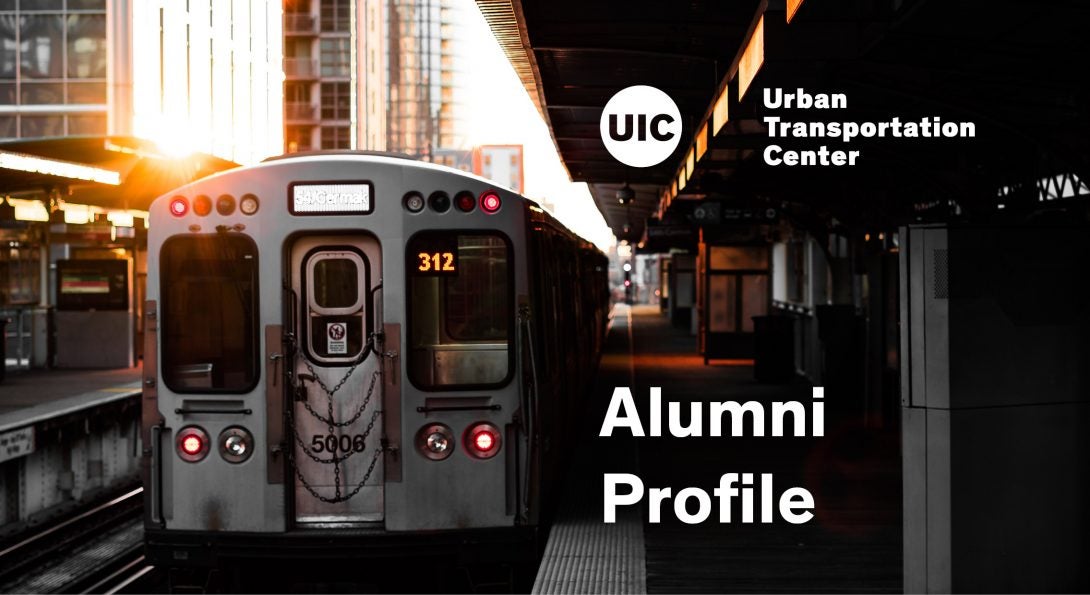Alumni Feature Profile: Jenny Kane

Jenny Kane, Transportation Consultant: A Candid Conversation
All public transportation systems are built to move people safely and efficiently; yet each system is unique and faces its own set of challenges. In her position with Transportation Resource Associates (TRA), Jenny Kane, MUPP, travels to metro areas across the nation to provide consulting services designed to help transit agencies operate better. Jenny holds the position of Project Analyst with TRA, the firm she joined after working as a UTC graduate research assistant and earning her Masters in Urban Planning and Policy (MUPP) degree from UIC in 2014.
Below, Jenny discusses her work, provides a perspective on key issues facing transit agencies today and shares thoughts on the value behind her work at the UTC.
Jenny Kane, MUPP, Project Analyst for TRA
What are your primary responsibilities as Project Analyst for Transportation Resource Associates?
TRA is a small, tight-knit firm where each of us works on multiple projects that can vary in scope, depth, duration, and location. On a given day, a Project Analyst might: arrange a site visit at a transit agency; review a transit agency plan or procedure and provide feedback; review a new or proposed regulation; and conduct an audit or assessment in the field. One of my favorite parts of the job is spending time at a transit agency speaking with workers about what they do. There is always something new to learn, even for industry veterans. We strive to identify best practices or a different way of looking at things that might improve safety or security, help a transit agency work more efficiently, or better serve the riding public.
TRA provides safety, security, and operations consulting to transit agencies. What transit agencies have you provided consulting services for, and please share further insight on what services you provided?
We work in all kinds of environments – traditional bus systems, bus rapid transit, “legacy” heavy rail rapid transit systems, fast growing light rail systems, brand new streetcar lines, inclined planes, airport people movers – you name it.
The Pennsylvania Department of Transportation (PennDOT) is one of our long-term clients and an example of State Safety Oversight support services we provide. Since about 1995, the states were required to establish their own safety and security oversight programs for fixed guideway transit systems, within certain federal guidelines. TRA assists PennDOT in its oversight of the covered transit properties in Pennsylvania. This involves tracking incidents and hazards, reviewing investigative reports, approving federally-required transit agency plans, meeting with agency personnel to discuss ongoing safety and security efforts, and conducting audits.
In the transit context, an audit can cover anything from operator training to track maintenance procedures, from accident investigations to hazardous materials storage in a maintenance shop. At their core, audits seek to:
1) Verify that the agency’s plans and procedures are compliant with regulations or standards and,
2) That the agency is implementing those plans and procedures as intended.
What results from the audit might be the identification of a hazard or area of potential improvement. Then the transit agency and State Safety Oversight Agency work together to plan a corrective action and track it to resolution. By providing this consulting service to numerous states nationwide, TRA can leverage its collective experience to suggest approaches that have worked elsewhere.
TRA also has transit agency clients that ask us to help them identify and implement improvements. This could entail an operations or maintenance-focused assessment of how to better utilize people and resources. The Metropolitan Atlanta Rapid Transit Authority (MARTA) is one client for whom we provide such services. We are not limited to transit, nor to the public sector: TRA works with clients in other industries to perform security assessments of threats and vulnerabilities, or to help write safety/security/emergency preparedness plans.
Now that you’ve been in the workforce for a few years, what do you think are the biggest challenges facing transit agencies nationwide?
While a graduate research assistant at the UTC, Jenny gained practical experience by contributing to various research studies.
I think reasonable people can disagree on this. An adage among the industry is: “If you’ve seen one transit agency, you’ve seen one transit agency.” Transit systems generally do not cross state lines or require inter-operability, nor do they compete with one another. We end up with agencies across the country that each have a unique set of circumstances – be it operating environment, technology and equipment, expectations from the public, and so on.
That said, there are definitely some big picture challenges affecting a number of agencies. A conundrum nearly all transportation and infrastructure sectors face is how to maintain a state of good repair while minimizing impacts to the public. Some of the oldest systems have served their cities remarkably well for decades, even a century or more. But they were not designed to carry as many people as current demand calls for, and may not have been designed to operate for as many hours. If there is only a small window overnight to work when trains aren’t running, it can be quite difficult to accomplish major repairs or upgrades. Agencies are trying to balance maintenance needs with their operational needs, all while trying to keep their riders informed and satisfied.
Second, there is the tension between maintaining what you’ve got and expanding capacity, given a discrete budget. Expansions are expensive – particularly dedicated right-of-way systems like subways, elevated lines, or dedicated lane bus and rail systems. Yet if you opt for a slower or less frequent service, fewer people may end up utilizing it, and it’s less likely to promote dense development. Cities and metro regions must choose whether to raise taxes, increase fares, or reduce spending elsewhere to pay for a big project like a new vehicle fleet, an extended rail line, or a bus rapid transit system. These decisions are rarely easy or straightforward. Based on where they live and work and how they travel, people may not want to pay a tax dedicated to a transit improvement that won’t provide much direct benefit. Fortunately, some financing options are available that do not require a significant up-front commitment of funds. There also seems to be an enhanced awareness by many Americans about the value of good transit. Hopefully, with that awareness and desire for transit options comes a willingness to help pay for it. Government entities like transit agencies must keep the public’s trust that tax dollars will be spent prudently.
Finally, the industry is aging. Only about one-third of transit employees today are under age 45. That means tens of thousands of people need to be hired and trained to replace retiring workers. Agencies may need to examine policies and budgets for opportunities to bring new people on board before a vacancy opens up; that way, there can be knowledge transfer. Another option is to bring back retirees part-time as instructors or advisors. Some transit agencies are proactively working with community colleges and vocational schools to develop apprenticeship programs.
Did your work as a graduate research assistant at the UTC have an impact on the work you’re conducting at TRA?
Ms. Kane uses Chicago’s Divvy bike share system regularly.
Absolutely, it did. Through UTC I had the opportunity to attend American Public Transportation Association (APTA) conferences and a Transportation Research Board (TRB) meeting. UTC also sent me to the Joint Rail Conference, where I gave a presentation on my master’s project. Exposure to events like that and guest lectures helped me learn about the industry and consider what type of work I’d like to do after graduation.
I spent my first year at UTC working on a literature review of value capture practices. Value capture is the concept of financing projects with the anticipation of increased property values and economic activity around where transit service is built. Many of the famous examples are in other countries, but we have some of our own right here like the addition of a new station on Washington, DC Metro’s Red Line.
During my second year at UTC, I helped research the New Starts program, which is a major federal grant program to fund new transit systems. Little did I know then I would end up working very closely with some New Starts recipients!
You’re now living back in Chicago after living in Philadelphia. What’s your perspective of local public transportation?
Living in Chicago has been an eye-opener for me on the usefulness of a grid street network. CTA’s bus system is phenomenal. The strong bus network has also helped CTA recently undertake major renovation projects on the Blue, Red, and Brown lines as disruptions to rail service can be partly absorbed by bus service.
Philadelphia’s SEPTA system is an amalgamation of different types of local rapid transit rail, commuter rail, and bus services that were originally separate companies and merged over time. Unlike CTA, SEPTA operates both local transit and commuter rail into the suburbs. Philadelphia is one of the only cities that continues to operate trollies. As other cities are now introducing or re-introducing street running rail, it is interesting to see how Philadelphia has continued to make it work. Another thing SEPTA has carried on longer than most systems is the use of tokens. CTA successfully deployed its modern fare collection system and Ventra app earlier than SEPTA, which is currently transitioning away from tokens.
All things considered, CTA and SEPTA have much in common: they are old, and can be loud and rough around the edges in places, but they are vital transportation networks. Whether you’re going to work at Willis Tower or the Comcast Center or to a game at Citizens Bank Park or Wrigley Field, transit is an accessible, reliable, and safe way to get there. I would argue they are each part of the culture and strength of their cities.
Now for some lighter stuff: You’re a renowned passenger train and bike share enthusiast. Do you still have time to pursue both given your busy travel schedule these days?
I’ve actually taken Amtrak for work trips to places like Minneapolis, Detroit, St. Louis, and Kansas City. Though it takes longer than flying, I’m able to work during the trip and meet interesting people. I like to hang out in the café or observation cars where conversations spontaneously happen.
Philadelphia debuted its bike share system, Indego, while I lived there. It was exciting to take part in the launch event and inaugural ride. Now that I’m back in Chicago, I ride Divvy pretty regularly. Although I did have a technical glitch with the Divvy dock when I recently tried to ride the Blackhawks branded bike while wearing a Flyers shirt. Hmm…
* * *
NOTE: If you are a former UTC graduate student researcher and would like to share information on your career in transportation or planning, please contact us via email.
MUPP, Project Analyst, Transportation Resource Associates

Responsibilities: “I conduct safety and security audits of rail transit systems through State Safety Oversight programs. The audits involve field work, interviews, and records review, and culminate with written reports of findings. I help states monitor transit agencies’ implementation of corrective actions to mitigate hazards and improve their operations.”
How UTC Prepared Me for a Career in Transportation: “UTC was a valuable experience not just through the work I conducted as a researcher, but also through the connections forged with industry professionals. There were frequent opportunities to attend presentations and conferences, enabling me to broaden my understanding of jobs and skill sets in the transportation realm.”